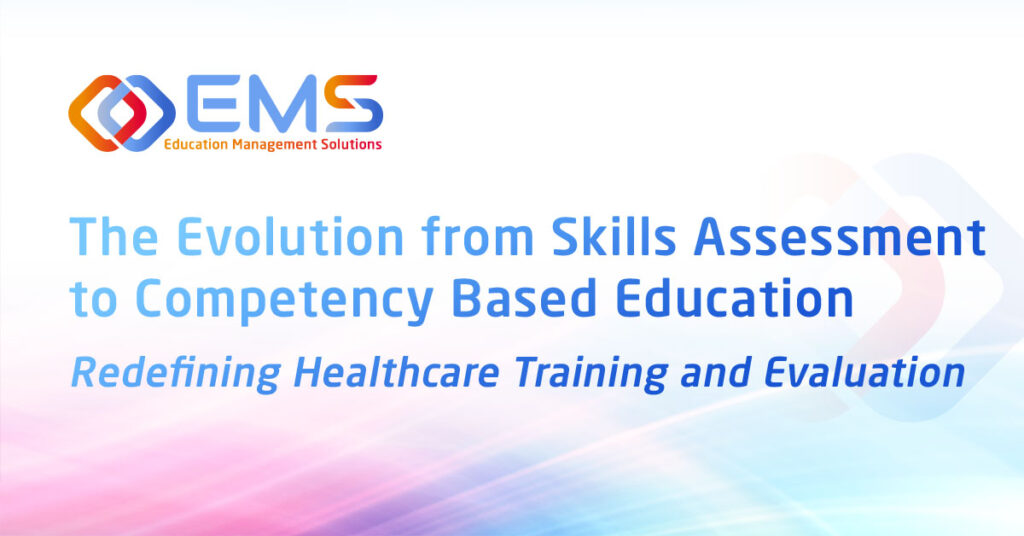In the landscape of professional development and educational assessment, a significant transformation is underway, with a pivot from traditional skills assessment towards the more nuanced and holistic approach of competency-based education (CBE). This article delves into the distinctions between these two methodologies, underscoring the benefits of the current transition to the adoption of more competency web frameworks.
From Isolation to Integration: The Shift to Competency
Skills Assessment has long been the cornerstone of educational and professional evaluation systems. Characterized by its focus on measuring specific, quantifiable skills or knowledge areas, this approach often relies on standardized testing methods.¹ While effective for evaluating narrowly defined outcomes, skills assessments frequently fall short in capturing the interconnectedness and breadth of competencies required to provide superior patient care in complex professional healthcare environments.
In contrast, the Competency paradigm advocates for a more expansive and integrated perspective on clinical capabilities. It recognizes the complex web of skills, knowledge, attitudes, and behaviors that constitute true competency in a profession². This approach moves beyond the fragmentation inherent in skills assessments, proposing a model that mirrors the real-world scenarios care-givers of all types navigate, where a dynamic interplay of various competencies is essential for success.
Advantages of Embracing a Competency Web Approach
The shift towards a competency framework is not merely academic; it offers tangible benefits in both higher education and professional worlds. By fostering a holistic view of competence, this approach facilitates the development of diverse skill sets, promoting versatile healthcare workers equipped to tackle the multifaceted challenges of modern workplaces³.
One of the key advantages of the competency web is its alignment with current educational philosophies that emphasize integrative learning and real-world applicability. It encourages the cultivation of critical thinking, collaboration, and adaptability, providing a more solid foundation for lifelong learning4. Additionally, the competency model supports personalized learning trajectories, acknowledging the individuality of learning paths or career progression.
Implementing Competency Web in Practice: Challenges and Strategies
Implementing a competency-based approach poses its own set of challenges, ranging from the necessity for comprehensive curriculum development to the need for innovative assessment methods that can accurately measure complex competencies. Addressing these issues going forward has a myriad of benefits including: further streamlined evaluation methods, decreased barriers to learning, and better educational outcomes. The solutions to these challenges lie in adopting multi-modal teaching and evaluation strategies that incorporate experiential learning, reflective practice, and formative feedback mechanisms5.
In the healthcare sector, in particular, simulation-based training designed around the competency model has shown promise in preparing medical professionals for the intricacies of clinical practice, emphasizing decision-making, teamwork, and patient-centered care.
Looking Ahead: The Future of Competency in Training and Development
The journey from skills assessment to a competency web signifies a profound transformation in how we understand and nurture professional competence. As this approach gains traction, it necessitates a systemic change in educational and organizational cultures, embracing a more fluid and interconnected conception of professional development.
The future promises advancements in assessment technologies and pedagogies that further facilitate the integration of the competency web model into curricula and workplace training programs. This evolution holds the potential to not only enhance individual performance but also to propel industries forward, paving the way for a more competent, agile, and adaptive workforce.
By comprehensively understanding and implementing the competency web model, educational institutions and industries can nurture a workforce that is not only technically proficient but also adept at navigating the complex, interconnected challenges of the professional world.
EMS Solutions: To Competency and Beyond
Education Management Solutions’ (EMS) Competency represents a progressive approach in the assessment and development of competencies in the healthcare training. Designed to move beyond mere skills assessment and encompass a broader, more comprehensive evaluation and enhancement of competencies across various domains, Competency addresses many of the challenges institutions face when transitioning to a competency-based model.
References
- Harden, R.M., & Crosby, J.R. (2000). AMEE Guide No. 20: The good teacher is more than a lecturer – the twelve roles of the teacher. Medical Teacher, 22(4), 334-347.
- Frank, J.R., et al. (2010). Competency-based medical education: theory to practice. Medical Teacher, 32(8), 638-645.
- Talbot, M. (2004). Monkey see, monkey do: a critique of the competency model in graduate medical education. Medical Education, 38, 587-592.
- Wagner, T. (2008). The Global Achievement Gap: Why Even Our Best Schools Don’t Teach the New Survival Skills Our Children Need—and What We Can Do About It. Basic Books.
- Issenberg, S.B., et al. (2005). Features and uses of high-fidelity medical simulations that lead to effective learning: a BEME systematic review. Medical Teacher, 27(1), 10-28.

